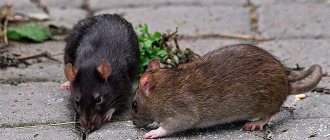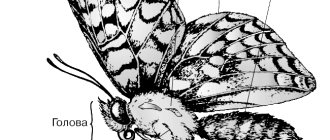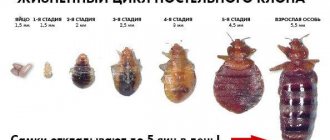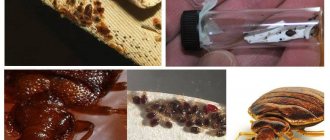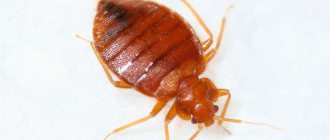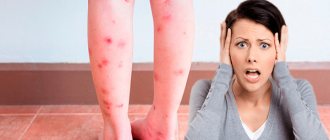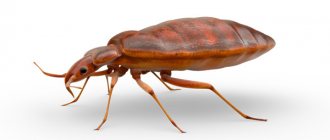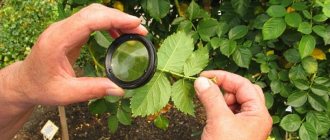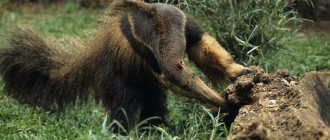- Reports and messages
- Insects
- Bedbugs
Bed bugs belong to the phylum arthropods, representatives of the class insects, from the order Hemiptera, one of the most numerous insects, about 40,000 thousand species, more than 50 families.
The body of the bug is wide, flat, 10–12 mm long, covered with a shield, colored in different colors. Each bug has 3 pairs of main limbs, all of them developed to varying degrees and used for swimming, moving and holding prey. Their unpleasant odor is the result of the work of special secret glands that are located on the chest. It is supposed to serve to scare away enemies. One of the features of bedbugs is their piercing-sucking type mouthparts, which look like a small proboscis, adapted for sucking out liquid substances. Another feature of the structure of bedbugs is their wings; they are dense in front, and thin and membranous at the edges; the number of wings varies for each species, from 2 to 4.
Bedbugs are widespread throughout the world, mainly prevailing in the tropics, warm countries, and are absent in the north, in the cold regions of our planet. Most species live on land, on the leaves and fruits of plants, feeding on their juice.
The most common bugs are bed bugs, consisting of more than 100 species, distributed throughout the planet. They live in human homes, mainly in the folds of furniture or clothing, in mattresses, under wallpaper and baseboards. Bedbugs not only cause trouble with their bites, but also cause irritation on the skin and can also cause trouble for pets. Some species of them are dangerous and severe agricultural pests; their presence on plants leads to their depletion and low yields.
Appearance of bedbugs
A distinctive feature of bedbugs is the structure of the front wings; they are called half-elytra, because they are hard in front and soft in the back. Some types of bedbugs have shortened wings or no wings at all.
Bedbugs have a piercing-sucking mouth. With the help of this proboscis, bedbugs suck out liquid substances. When the bug is not feeding, the proboscis is tucked under the head.
Most bedbugs have scent glands. The smell of bedbugs has a signaling value: with its help, males and females find each other or scare away enemies.
Gray shieldweed (Elasmucha grisea).
The large bug Tessarotoma papillosa, which lives in Asia, throws out the secretion of the odorous glands 10-15 centimeters; if this secretion gets on the skin or eyes, it provokes a strong burning sensation.
Nutrition
A parasitic lifestyle and feeding on blood is characteristic of both sexes of the imago, as well as the larval stage. A bedbug is a parasite that sucks blood primarily from humans (sometimes it attacks birds, cats, dogs, rats, mice, rabbits, bats, and ungulates). Itchy blisters form at the site of the bites. The proboscis of a bedbug makes a wound in human skin that is 500 times smaller than the thinnest syringe needle. In 10 minutes, a female bedbug manages to pump twice her own weight in blood. In the dark, bedbugs come out of their shelter and attack a person (suck blood on open areas of the body), usually at 3-8 o'clock in the morning. Bedbugs feed exclusively on blood. They can live up to one and a half years without food.
Reproduction of bedbugs
Bugs lay eggs on the surface of plants or introduce them into plant tissue. Some species take care of their offspring: the female lays eggs on the back of the male, and he carries them throughout the entire period of development. And the females of tree bugs living in Japan feed the larvae and bring them fruits of a tree of the olax family to their nest every day. Interestingly, some females steal these fruits from nests left unattended. Upon completion of larval development, the nest may contain about 150 fruit seeds.
Bedbug eggs are quite large. At the top of each egg a cap opens, through which the larva emerges.
A feature of bedbug eggs is the presence of a lid at the top, which opens and the larva comes out.
Development has incomplete transformation. The larvae are similar to adult bedbugs not only in appearance, but also in their lifestyle. Like many insects, larvae and adult beetles grow in leaps and bounds, during the molting period, at the moment when the old shell is shed and the new one has not yet hardened, growth occurs. Most often, larvae molt 5 times. With each molt, the wing rudiments become more and more visible. Overwintering usually occurs in the adult or egg stage, as in horse flies.
Colorful bug nymph
Lifestyle
The bedbug is nocturnal, and during the day it hides in cracks in walls, under wallpaper, in grooves of furniture, books, clothes, beds, electronics, in dark and warm places, in bird and animal cages; however, in severe hunger, it can attack during the day. Sometimes it falls on its victim directly from the ceiling of the room. The bedbug detects the presence of a person from a considerable distance by smell and emitted heat. It is believed that its thermoreceptors are located on its antennae. If you put bedbugs in a test tube and put your finger near it, they will instantly crawl towards it.
In the absence of food, bedbugs can enter a state similar to suspended animation, in which they remain viable for more than one year. In unfavorable conditions, bedbugs are able to migrate between rooms through ventilation ducts, and in the summer - along the outer walls of houses. An adult bug travels over 1 m in one minute, a nymph - up to 25 cm.
Distribution and diversity of bedbugs
Geographically, bedbugs are very widespread. They only avoid cold zones, but in areas with temperate climates they live everywhere. As you move south, the number and variety of bedbugs increases.
Northern eurydemas, belonging to the genus of cruciferous bugs, are pests of cabbage plants.
Most species of bedbugs are terrestrial, but some species prefer an aquatic environment, and they live in rivers, lakes and even puddles. Bedbugs are the only representatives of insects that have conquered the sea. Tropical water striders Halobates live on the surface of the ocean; they do not even come to land during the breeding season.
Popular message topics
- The work of Denis Cooper
Denis Cooper is a famous American writer and artist, born into a wealthy merchant family in California. At a very young age Cooper was exposed to the works of some famous Western - Judicial system
The judicial system is a separate network of strictly specialized government bodies, exclusively state, which exercise the functions of justice on the territory of the state. - Joan of Arc
A national heroine of France, canonized by the Catholic Church of Rome, Joan of Arc is one of the most significant figures of the Hundred Years' War of 1337-1453. Born in 1412 in the Lorraine village of Domremy, the origins of her family are not reliably known.
The importance of bedbugs in agriculture
Among ground bugs there are a large number of pests of agricultural crops. They suck juices from plants and reduce yields. Some of the most common pests are stink bugs, pest bugs, beet bugs, alfalfa bugs, bread bugs and wandering horse flies.
However, bedbugs can also be useful for agriculture - predatory bugs destroy a variety of pests, such as caterpillars, beetle larvae, aphids, and the like.
If you find an error, please select a piece of text and press Ctrl+Enter.
High adaptive abilities
Not every remedy can poison a parasite. An insufficient layer on the treated surface leads to the development of lasting immunity. The poison enters the body in a minimal amount, but does not kill the insect, but acts like a vaccine. The bug will get over the disease, and after a few days it will continue to parasitize, but will already be resistant to the effects of the poison. Repeated treatment with a product with a similar component will not give the desired result.
A gradual increase in the concentration of the toxic substance leads to the fact that bed bugs cease to be afraid of the poison. For this reason, it is difficult to remove parasites that entered the apartment from neighbors when they poisoned them.
On a note!
A bug bite causes an allergic reaction of varying severity, depending on the individual characteristics of the body. With a strong reaction, signs of suffocation occur, even death if emergency assistance is not provided.
Prevention
To prevent the appearance of parasites in your home:
- always carefully check new furniture or mattresses purchased in a store before you bring them home, otherwise you will have to remove bedbugs from the sofa and other furniture;
- if you sometimes stay in hotel rooms, check mattresses and seams for excrement, and place luggage on the table rather than on the table;
- Carry out systematic cleaning of the house: wash floors, baseboards, clean furniture and carpets;
- check for cracks and cracks in the walls; repair any existing ones;
- When vacuuming, get into hard-to-reach places (openings, under sofas and armchairs);
- change bed linen more often, wash it, do not store dirty linen in the basket for a long time;
- if you were visiting people who have bedbugs in their home, wash your bag and clothes when you get home;
- refuse a gift in the form of old furniture and do not pick up discarded furniture, even if it looks good;
- If there are a lot of books in your apartment, try to periodically inspect them, wipe them and the shelves on which they stand with a damp cloth.
It is also important that bedbugs thrive both in unsanitary conditions and in conditions of absolute sterility. For them, the main thing is that there is food nearby, in the form of a human body.
They can easily migrate from one apartment to another. Therefore, if your neighbors have these insects, then most likely, after some time they will appear on you. The only consolation is that there are many folk remedies for bedbugs and chemicals.
Bed bugs can enter a room through vents, electrical outlets, cracks in walls and floors, and through windows and doors. Therefore, it is quite difficult to protect against them.
But knowing what bedbugs look like, you can protect your home at the first sign of their appearance.
Morphology
Scanning electron microscope image of a bug of the species Cimex lectularius. Colors were added digitally, with parts of the mouthparts intended for piercing the skin highlighted in purple and red.
The bedbug has a strongly flattened body ranging from 3 to 8.4 mm in length, depending on blood saturation. Males are on average smaller than females. Color ranges from dirty yellow to dark brown. A proboscis extends from the anterior edge of the head, adapted for piercing tissue and sucking blood. The upper and lower jaws have the appearance of piercing, undivided bristles and form two channels: a wide one for receiving blood and a narrow one for secreting it into the injection site.
Thanks to the geometry and flexibility of the segmented body, the hungry bug is weakly vulnerable to mechanical methods of combating it. A well-fed bug becomes less mobile, its body acquires a more rounded shape and a color corresponding to blood (by the color of which - from scarlet to black - you can roughly determine when this individual last fed).
Literature
- Vinokurov N. N., Kanyukova E. V., Golub V. B. Catalog of hemipteran insects (Heteroptera) of the Asian part of Russia. — Publisher: SIF “Nauka”, Novosibirsk, 2010, 320 p. ISBN 978-5-02-023318-8
- Vinokurov N. N., Kanyukova E. V. Hemipteran insects (Heteroptera) of Siberia. - Novosibirsk: Nauka SIF RAS, 1995. - 238 p.
- Harmful turtle. Collection, vol. 1-4, M. - L., 1947-60.
- Kanyukova E. V. Aquatic hemiptera insects (Heteroptera: Nepomorpha, Gerromopha) of the fauna of Russia and neighboring countries. — Publisher: “Dalnauka”, Vladivostok, 2006, 297 p. ISBN 5-8044-0645-0
- Kerzhner I. M. and Yachevsky T. L., Order Hemiptera (Heteroptera) - hemiptera, or bugs, in the book: Key to insects of the European part of the USSR, vol. 1, M. - L., 1964.
- Methods for collecting real hemipterans and studying local faunas, M. - L., 1957.
- True hemiptera of the European part of the USSR. Key and bibliography, M. - L., 1951
- Hemiptera, in the book: Animal World of the USSR, vol. 1-5, M. - L., 1936-58.
- Saulich A. Kh., Musolin D. L. Seasonal development of aquatic and semi-aquatic hemipteran insects (Heteroptera). - St. Petersburg University Publishing House, St. Petersburg, 2007, 205 p. ISBN 978-5-288-04332-1
- Animal Life, ed. L. A. Zenkevich, vol. 3. M., 1969.
- Bedbugs //: in 86 volumes (82 volumes and 4 additional ones). - St. Petersburg, 1890-1907.
Proven methods of struggle
The fight against bedbugs has its own characteristics. Firstly, bedbugs, unlike other household pests such as cockroaches and ants, have an organism that is resistant to many insecticides. Therefore, their use may give poor results. And secondly, the body of bedbugs has the ability to very quickly adapt to external environmental threats, that is, to those poisons that people use to combat insect pests.
However, bedbugs can and should, of course, be fought against.
It is important to choose the most suitable method for you. For best results, use proven control methods
For example, temperature methods, the purpose of which is to destroy bedbugs by exposing them to high or low temperatures. This includes freezing bedbugs, washing contaminated clothes in hot water, or treating bedbugs with boiling water.
The advantage of these methods is that they are absolutely harmless to humans and do not carry with them consequences that can ruin their health. But using low temperatures can cause pipes to burst, and high temperatures require expensive equipment, which not every disinfection service has.
The second method is the use of insecticides. They are used in aerosol form to completely destroy bedbugs in the area where they are located. This method is the most popular and versatile, since it is easy to use, does not require expensive equipment and allows you to fight bedbugs on your own. The disadvantage of this method is that some people are sensitive to the chemicals contained in insecticides.
Methods of repelling bedbugs using certain means are widely used in everyday life. For example, essential oils such as eucalyptus and rosemary, which have a very pleasant smell and at the same time are a good remedy for repelling bedbugs. For them, the smell of oils is quite strong and unpleasant. You can use various chemical liquids that smell less pleasant to humans, but are no less effective for preventing bedbugs, such as kerosene, ammonia and others.
hloptarakan.ru
